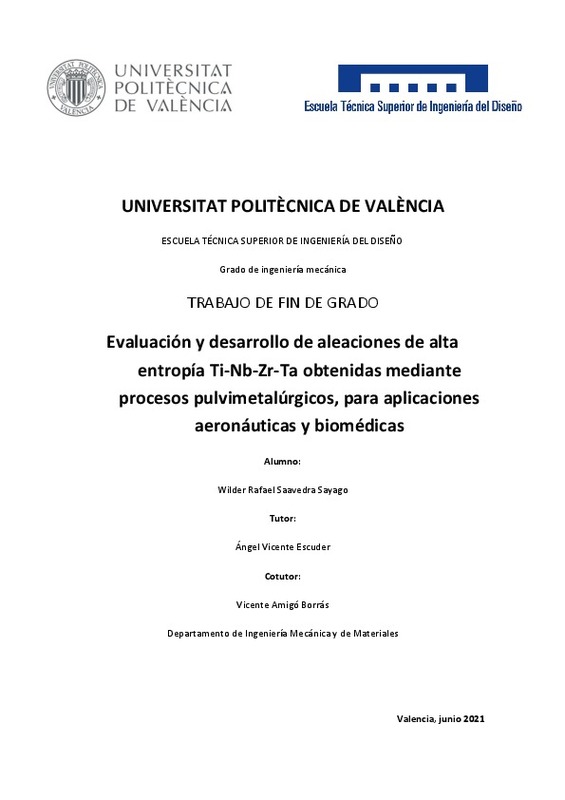|
Resumen:
|
[ES] En los últimos años sean desarrollado algunas aleaciones de alta entropía con interesantes propiedades de diferentes sectores. Sin embargo, su desarrollo no resulta sencillo al resultar una mezcla prácticamente ...[+]
[ES] En los últimos años sean desarrollado algunas aleaciones de alta entropía con interesantes propiedades de diferentes sectores. Sin embargo, su desarrollo no resulta sencillo al resultar una mezcla prácticamente equiatómica de diferentes elementos, mínimo cuatro de ellos. Si además se busca una gran biocompatibilidad para su posible aplicación biomédica, su desarrollo se centra en cuatro elementos fundamentales como el titanio, circonio, niobio y tantalio. Todos ellos son elementos de elevado punto de fusión, especialmente el niobio y tantalio, por lo que se dificulta su obtención por técnicas de colada. Por ello se propone trabajar con pulvimetalurgia que puede permitir, de una manera más sencilla y eficaz, la difusión entre los distintos elementos y por tanto la obtención de la aleación. Esto no se espera que sea sencillo ni que pueda tenerse éxito cando se realizan mezclas de los polvos elementales, por la alta temperatura de fusión anteriormente indicada, y se recurrirá ya en su planificación a desarrollar polvos mediante técnicas de aleado mecánico en molinos de alta energía. Con ello se espera que la difusión pueda ser más efectiva.
Obtenidas las muestras, se caracterizarán mecánica y estructuralmente. En el caso de que se obtengan muestras adecuadas, se procederá también a evaluar la resistencia frente a la corrosión y oxidación. Realmente se considera un trabajo experimental de riesgo, en cuanto que puede tenerse problemas tanto en la obtención de las diferentes muestras, debido a defectos importantes de porosidad y sobre todo agrietamiento, pero incluso teniendo éxito en esta parte pueden presentarse también defectos importantes en el material sinterizado, como falta de homogeneidad química, pobres propiedades finales, etc. Es por esto que el trabajo constituye un verdadero reto para el estudiante que recibirá todo nuestro apoyo a lo largo del desarrollo de proyecto y le permitirá aprender técnicas y procesos, pero sobre todo a ser crítico con su pensamiento, a valorar las aportaciones de otros autores y a planificar perfectamente el trabajo a desarrollar.
[-]
[EN] In recent years some high entropy alloys with interesting properties from different sectors have been developed. However, its development is not easy as it is a practically equiatomic mixture of different elements, ...[+]
[EN] In recent years some high entropy alloys with interesting properties from different sectors have been developed. However, its development is not easy as it is a practically equiatomic mixture of different elements, at least four of them. If, in addition, a great biocompatibility is sought for its possible biomedical application, its development focuses on four fundamental elements such as titanium, zirconium, niobium and tantalum. All of them are elements with a high melting point, especially niobium and tantalum, which makes them difficult to obtain by casting techniques. For this reason, it is proposed to work with powder metallurgy that can allow, in a simpler and more efficient way, the diffusion between the different elements and therefore the obtaining of the alloy. This is not expected to be simple or to be successful when mixtures of elemental powders are made, due to the high melting temperature previously indicated, and it will already be resorted to in planning to develop powders using mechanical alloying techniques in high energy mills. . With this, it is expected that the diffusion can be more effective.
Once the samples are obtained, they will be mechanically and structurally characterized. In the event that adequate samples are obtained, the resistance to corrosion and oxidation will also be evaluated. It is really considered a risky experimental work, in that there may be problems both in obtaining the different samples, due to important porosity defects and especially cracking, but even if it is successful in this part, there may also be important defects in the material sintered, such as chemical inhomogeneity, poor final properties, etc. That is why the work constitutes a real challenge for the student who will receive all our support throughout the development of the project and will allow him to learn techniques and processes, but above all to be critical of his thinking, to value the contributions of other authors and to perfectly plan the work to be carried out.
[-]
|







